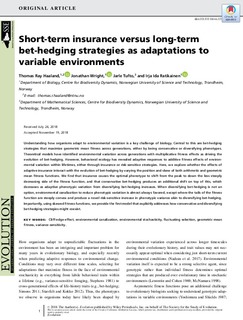| dc.contributor.author | Haaland, Thomas | |
| dc.contributor.author | Wright, Jonathan | |
| dc.contributor.author | Tufto, Jarle | |
| dc.contributor.author | Ratikainen, Irja Ida | |
| dc.date.accessioned | 2019-04-02T08:36:30Z | |
| dc.date.available | 2019-04-02T08:36:30Z | |
| dc.date.created | 2019-01-14T13:33:43Z | |
| dc.date.issued | 2018 | |
| dc.identifier.citation | Evolution. 2018, 73 (2), 145-157. | nb_NO |
| dc.identifier.issn | 0014-3820 | |
| dc.identifier.uri | http://hdl.handle.net/11250/2592856 | |
| dc.description.abstract | Understanding how organisms adapt to environmental variation is a key challenge of biology. Central to this are bet‐hedging strategies that maximize geometric mean fitness across generations, either by being conservative or diversifying phenotypes. Theoretical models have identified environmental variation across generations with multiplicative fitness effects as driving the evolution of bet‐hedging. However, behavioral ecology has revealed adaptive responses to additive fitness effects of environmental variation within lifetimes, either through insurance or risk‐sensitive strategies. Here, we explore whether the effects of adaptive insurance interact with the evolution of bet‐hedging by varying the position and skew of both arithmetic and geometric mean fitness functions. We find that insurance causes the optimal phenotype to shift from the peak to down the less steeply decreasing side of the fitness function, and that conservative bet‐hedging produces an additional shift on top of this, which decreases as adaptive phenotypic variation from diversifying bet‐hedging increases. When diversifying bet‐hedging is not an option, environmental canalization to reduce phenotypic variation is almost always favored, except where the tails of the fitness function are steeply convex and produce a novel risk‐sensitive increase in phenotypic variance akin to diversifying bet‐hedging. Importantly, using skewed fitness functions, we provide the first model that explicitly addresses how conservative and diversifying bet‐hedging strategies might coexist. | nb_NO |
| dc.language.iso | eng | nb_NO |
| dc.publisher | Wiley | nb_NO |
| dc.relation.uri | https://onlinelibrary.wiley.com/doi/full/10.1111/evo.13659 | |
| dc.rights | Navngivelse 4.0 Internasjonal | * |
| dc.rights.uri | http://creativecommons.org/licenses/by/4.0/deed.no | * |
| dc.title | Short‐term insurance versus long‐term bet‐hedging strategies as adaptations to variable environments | nb_NO |
| dc.type | Journal article | nb_NO |
| dc.type | Peer reviewed | nb_NO |
| dc.description.version | publishedVersion | nb_NO |
| dc.source.pagenumber | 145-157 | nb_NO |
| dc.source.volume | 73 | nb_NO |
| dc.source.journal | Evolution | nb_NO |
| dc.source.issue | 2 | nb_NO |
| dc.identifier.doi | 10.1111/evo.13659 | |
| dc.identifier.cristin | 1656342 | |
| dc.relation.project | Norges forskningsråd: 240008 | nb_NO |
| dc.relation.project | Norges forskningsråd: 223257 | nb_NO |
| dc.description.localcode | © 2018 The Author(s). Evolution published by Wiley Periodicals, Inc. on behalf of The Society for the Study of Evolution. This is an open access article under the terms of the Creative Commons Attribution License. | nb_NO |
| cristin.unitcode | 194,66,10,0 | |
| cristin.unitcode | 194,63,15,0 | |
| cristin.unitname | Institutt for biologi | |
| cristin.unitname | Institutt for matematiske fag | |
| cristin.ispublished | true | |
| cristin.fulltext | postprint | |
| cristin.fulltext | original | |
| cristin.qualitycode | 2 | |

